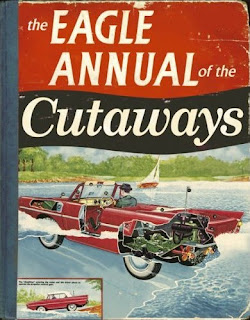Review by Jeremy Briggs
After last year’s uninspiring Eagle Annual: The Best Of The 1950s Comic, its sequel Best of the 1960s Comic has been put on hold to 2009 and this year’s offering from Orion is the unwieldily entitled The Eagle Annual Of The Cutaways edited by Daniel Tatarsky.
 This is has been a book I have been looking forward to since it was announced as my favourite part of original Eagle is not Dan Dare but the cutaways, all the better if they are by Leslie Ashwell-Wood and best when they are military aircraft. So, after opening the book to find that the frontispiece was six cutaways taken from the original artwork and beginning with a Royal Navy Supermarine Attacker jet being launched from an aircraft carrier… well things couldn’t have started better. Indeed, there are eighteen cutaways at the beginning and end of the book taken from the original art boards with no published text other than the circular numbers which Eagle fans know were painted onto the artwork.
This is has been a book I have been looking forward to since it was announced as my favourite part of original Eagle is not Dan Dare but the cutaways, all the better if they are by Leslie Ashwell-Wood and best when they are military aircraft. So, after opening the book to find that the frontispiece was six cutaways taken from the original artwork and beginning with a Royal Navy Supermarine Attacker jet being launched from an aircraft carrier… well things couldn’t have started better. Indeed, there are eighteen cutaways at the beginning and end of the book taken from the original art boards with no published text other than the circular numbers which Eagle fans know were painted onto the artwork.
Despite them being trimmed at either end due to their length, they are superb reproductions.
Unfortunately when he describes the idea of setting Dan Dare’s Space Fleet HQ in Formby on the Lancashire coast as being “simply very funny”, that a “shopping mall, yes, a centre for engineering, design, military and scientific excellence, don’t be daft…” he obviously is unaware that such a centre is barely five miles from Formby at Warton where English Electric designed, manufactured and flew the Canberra bomber in those early days of Eagle and where, today, BAE Systems are doing the same for its modern equivalent, the Typhoon.
What little information there is here on the artists, bar a mention of him having had “tentative dealings” with cutaway artist John Batchelor, appears to show that he has read Steve Holland’s biography of Leslie Ashwell-Wood on Bear Alley and Will Grenham’s piece on the cutaway artists on Eagle-Times, yet he neglects to mention by name over two thirds of those artists, including many whose work appears in the book.
Perhaps the most interesting of these are the futuristic ones which include Ashwell-Wood’s version of a Channel Tunnel on pages 48 and 49 and Gordon Davies’ 10000mph Atomic Airliner on pages 54 and 55.
 The 1950s style cutaways are replaced by the 1960s single page style from page 130 onwards. Here, the cutaway style changes made in the Eagle, as the comic went downhill in the mid to late 1960s, are evident as they lose their colour and some are even incorporated into text features. Yet they are still interesting, with two different cutaways of Concorde by Ashwell-Wood and, perhaps the most unusual of the 1960s batch, a hover truck spraying a ploughed field by Geoffrey Wheeler.
The 1950s style cutaways are replaced by the 1960s single page style from page 130 onwards. Here, the cutaway style changes made in the Eagle, as the comic went downhill in the mid to late 1960s, are evident as they lose their colour and some are even incorporated into text features. Yet they are still interesting, with two different cutaways of Concorde by Ashwell-Wood and, perhaps the most unusual of the 1960s batch, a hover truck spraying a ploughed field by Geoffrey Wheeler.
However, I can’t tell you which page it is on because by this point, the book has abandoned its page numbering, which is one of the greatest drawbacks of the book. With no page numbers on most of the last third of the book, there is no way of indexing the illustrations and so no attempt has been made. While they may be in a vague chronological order between the 1950s and the 1960s, there aren’t even any themes to the book where, for example, all the cars are together. As a consequence, there is no easy way of finding any given illustration in the book’s 180-odd pages.
Perhaps the most annoying thing for fans of the original comic will be the lack of any attempt to date the art to the issue of the comic it came from. Although a few of the 1960s pages retain their dates this is more by good fortune than by design.
That said, if you are just buying the book for the art then it is a good purchase: but if you are buying the book as reference for the artists or their work, you will be disappointed.
Categories: British Comics
 In Review: The 2000AD Art of Sean Phillips
In Review: The 2000AD Art of Sean Phillips  Beano x Comixit! team up, bringing Dennis, Gnasher, Bananaman and more to life in the palm of kids’ hands
Beano x Comixit! team up, bringing Dennis, Gnasher, Bananaman and more to life in the palm of kids’ hands  Rogue Trooper: Ghost Patrol collection incoming
Rogue Trooper: Ghost Patrol collection incoming  Vintage Comics aplenty, Frank Bellamy and Roy Wilson art, offered in latest Phil-Comics auction
Vintage Comics aplenty, Frank Bellamy and Roy Wilson art, offered in latest Phil-Comics auction
I agree with all the points raised above. There is no mention of Walkden Fisher, though his fish logo appears on a number of the drawings.
A number of the drawings have resonances with drawings Ashwell Wood had made for various war-time Odhams books. The Primrose Hill junction [p 121-121] and the hump marshalling yard, pp100-101 both feature in *The Worlds Railways and How They Work*, (1948). In turn the Odhams book drawings were sometimes re-workings of drawings that had appeared in *Modern Wonder* in the late 1930s.
Jonathan Clancy’s introduction has some interesting insights, particularly concerning the fact that interest in this kind of art fizzled out in the 1960s.
This neglect is reflected now in general publishing of books about engineering and technology for young people. There were numerous writers active from about 1900 starting with Archibald
Williams, and then Ellison Hawks. The 30s saw the four part works edited by Clarence Winchester
There was the fine Odhams series during the second World War. and a number of other books until the 60s
The genre does not appear at all in modern academic studies of children’s books.
Information about writers and artists is very sparse indeed.
The genre really needs scholarly investigation.